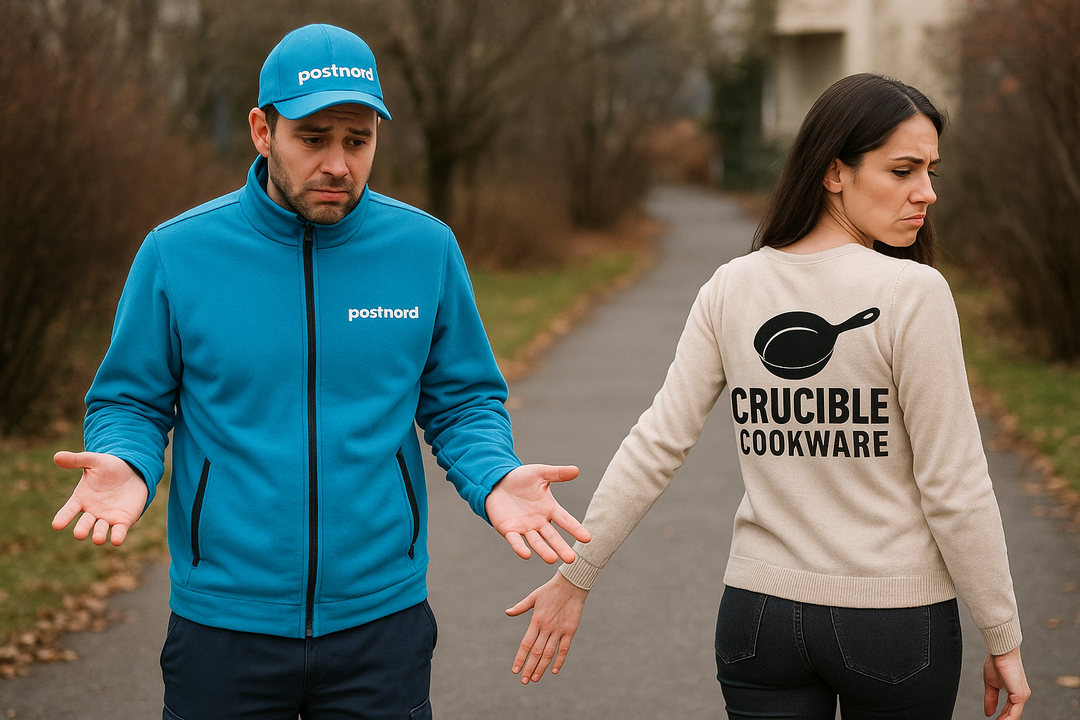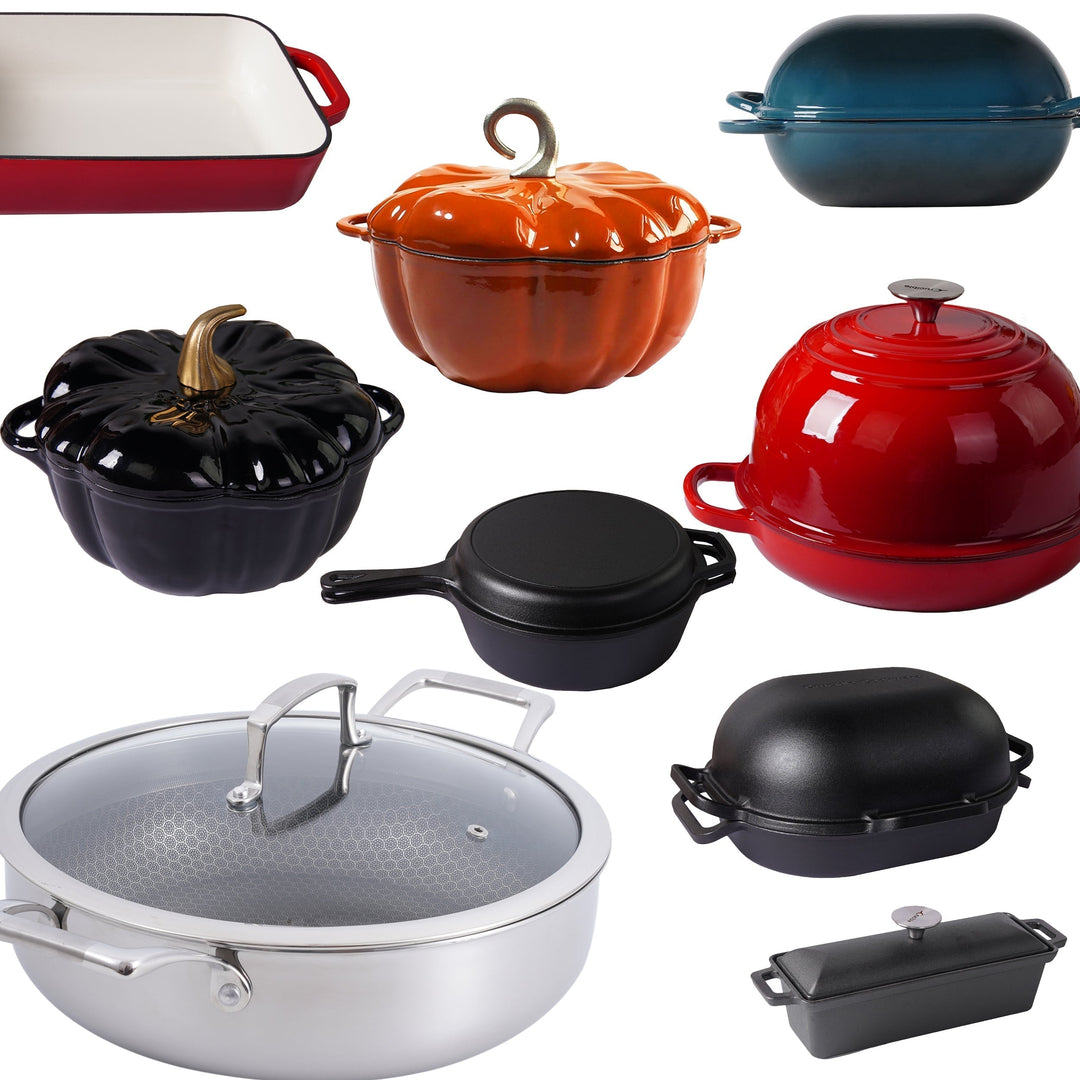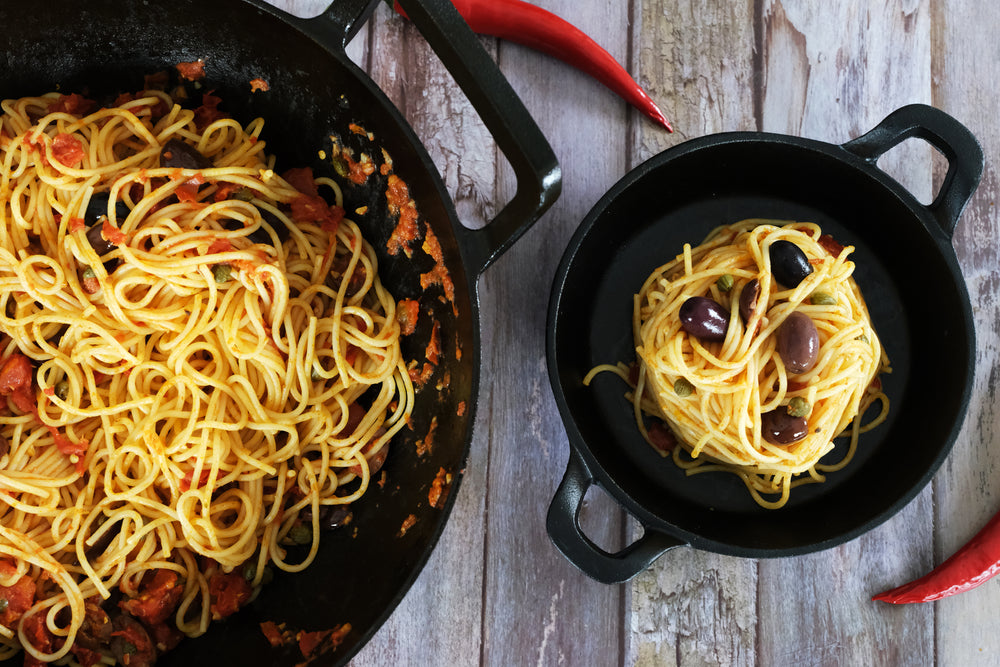Valurautaisen ruoanlaiton tiede: Miksi se kypsentää paremmin ja kestää pidempään

Valurautaiset keittiövälineet ovat olleet keittiöiden perusta vuosisatojen ajan, ja monet kokit ja kotikokit vannovat niiden vertaansa vailla olevan kypsennystehokkuuden nimeen. Mutta mikä tekee valuraudasta niin erityisen? Miksi se säilyttää lämmön niin hyvin, ja miksi se näyttää paranevan iän myötä?
Tässä kirjoituksessa pureudumme valuraudan tiedeeseen ja tutkimme, miksi se kypsentää paremmin, kestää pidempään ja pysyy olennaisena keittiövälineenä ympäri maailmaa.
Lämmönvaraus ja tasainen kypsennys
Yksi valuraudan erottuvista ominaisuuksista on sen ylivoimainen lämmönvarauskyky. Toisin kuin kevyet pannut, jotka kuumenevat nopeasti mutta jäähtyvät yhtä nopeasti, valurauta säilyttää lämmön pidempään. Tämä tekee siitä ihanteellisen ruoanlaittotekniikoihin, jotka vaativat tasaista lämpöä, kuten ruskistamiseen, paistamiseen ja leivontaan.
Miksi se säilyttää lämmön niin hyvin?
Valurauta koostuu pääasiassa raudasta, pieninä määrinä hiiltä ja muita alkuaineita. Materiaalin tiheä rakenne mahdollistaa lämmön tehokkaan imeytymisen ja varastoinnin. Kun se on kuumennettu, valurauta säilyttää lämmön paljon pidempään kuin muut metallit. Materiaalin paksuus on myös tekijä; paksummat pannut voivat varastoida enemmän lämpöä, mikä tekee niistä täydellisiä hauduttamiseen tai ruoan pitämiseen lämpimänä pitkien aikojen ajan.
Sisäänpolton merkitys: tarttumattoman pinnan luominen
Toinen valurautakeittiövälineiden määrittävä ominaisuus on niiden sisäänpoltto, öljykerros, joka paistetaan pannun pinnalle valmistuksen tai huollon aikana. Vaikka sisäänpoltto usein nähdään pelkkänä "huoltotehtävänä", sen tarpeellisuuden takana on todellista tiedettä.
Miten sisäänpoltto toimii
Kun sisäänpoltat Dutch oven -pannusi, levität siihen ohuen kerroksen öljyä (yleensä kasviöljyä tai pellavansiemenöljyä) ja kuumennat sen, kunnes se polymeroituu, muuttaen öljyn kestävään, tarttumattomaan pinnoitteeseen. Mutta miksi se toimii niin hyvin?
Tämä polymerointiprosessi luo vahvan sidoksen öljymolekyylien ja pannun pinnan välille, täyttäen raudan pienet huokoset ja karheat kohdat. Tämä sileä pinta auttaa ruokaa liukumaan helposti pois ja estää ruostetta luomalla kosteudelta suojaavan esteen.
Kestävyys: Valuraudan ajaton luonne
Valurauta on tehty kestämään, eikä kyse ole pelkästään huolenpidosta; se on materiaalin koostumuksessa. Toisin kuin muut keittiövälineet, jotka voivat vääntyä, naarmuuntua tai lohjeta ajan myötä, valurauta muuttuu kestävämmäksi jokaisella käyttökerralla, erityisesti jos se on hyvin sisäänpoltettu.
Miksi valurauta kestää niin pitkään?
Valurautaisen tiheys ja rakenne tarkoittavat, että se kestää korkeita lämpötiloja, toistuvaa käyttöä ja jopa ajan koettelemuksen. Valurautaiset keittiövälineet voivat kestää sukupolvien ajan—jotkut vintage-kappaleet ovat edelleen käytössä niiden poikkeuksellisen kestävyyden vuoksi.
Toisin kuin ruostumattomasta teräksestä tai tarttumattomista pinnoista valmistetut pannut, valurauta ei väänny tai menetä kykyään kypsentää pitkän käytön jälkeen. Tämä johtuu siitä, että materiaalilla ei ole luontaisia heikkouksia, jotka lämpö voisi vaurioittaa, ja sen luonnollinen sisäänpoltto suojaa pintaa entisestään.
Valuraudan ainutlaatuinen ruoanlaittosuorituskyky
Toinen tärkeä syy, miksi kokit suosivat valurautaa, on sen kyky jakaa lämpö tasaisesti. Tämä tekee siitä ihanteellisen moniin ruoanlaittotapoihin, paistamisesta leivontaan.
Tasainen lämmönjakautuminen
Valurautapannut lämpenevät hitaasti, mutta ylläpitävät tasaisen lämpötilan koko pinnalla. Tämä tarkoittaa, että ruoka ei kypsy epätasaisesti, mikä vähentää kuumien kohtien riskiä ja varmistaa, että ateriasi kypsyvät aina täydellisesti. Olitpa sitten paistamassa pihviä tai hauduttamassa pataruokaa, valuraudan lämmönvaraus takaa tasaisen kypsennyksen.

Miksi valurauta paranee iän myötä
Vaikka monet materiaalit heikkenevät tai menettävät kiiltonsa ajan myötä, valurauta vain paranee käytön myötä. Sisäänpoltto kerros paksuuntuu ja vahvistuu ajan myötä, tarjoten jokaisella aterialla entistä kestävämmän tarttumattoman pinnan.
Kuinka ikääntyminen parantaa ruoanlaittokokemusta
Joka kerta kun käytät valurautaasi ruoanlaittoon, sisäänpoltto paranee hieman. Ruoanlaitossa käytetyt öljyt edistävät sisäänpolttoa, ja säännöllisellä käytöllä huomaat valurautasi kypsentävän entistä sujuvammin. Siksi jotkut kokit arvostavat vanhoja valurautapannujaan, sillä niissä on usein luonnostaan parempi kypsennys pinta, jonka vuosien käyttö on hiouttanut.
Lyhyt katsaus valurautaisten keittiövälineiden historiaan
Valurautaisten keittiövälineiden historia ulottuu 5. vuosisadalle eaa., jolloin Kiinassa käytettiin ensimmäisiä valurautamuotoja. 1700-luvulla valurautaa käytettiin Euroopan ja Amerikan keittiöissä, ja se sai nopeasti suosiota kestävyyden ja monipuolisuuden ansiosta. Jopa nykyaikaisissa keittiöissä valurauta on suosittu, arvostettu sen kyvystä säilyttää lämpöä, kypsentää tasaisesti ja kestää sukupolvien ajan.
Lopuksi
Valuraudan uskomaton lämmönvarauskyky, tasainen kypsennys, kestävyys ja sisäänpoltto tekevät siitä yhden luotettavimmista ja pitkäikäisimmistä keittiövälineistä. Valuraudan takana oleva tiede on yksinkertaista mutta syvällistä: se on tiheä, kestävä materiaali, joka vain paranee ajan myötä, tehden siitä monien keittiöiden rakastetun osan.
Olitpa sitten käyttämässä sukupolvelta toiselle periytynyttä hyvin kulunutta paistinpannua tai kiiltävää uutta Dutch ovenia, valurautaisen ruoanlaiton suorituskyky ja kestävyys ovat vertaansa vailla. Mitä enemmän sitä käytät, sitä paremmaksi se muuttuu – ja sitä ei mikään muu keittiövälineen materiaali voi väittää.
















Jätä kommentti